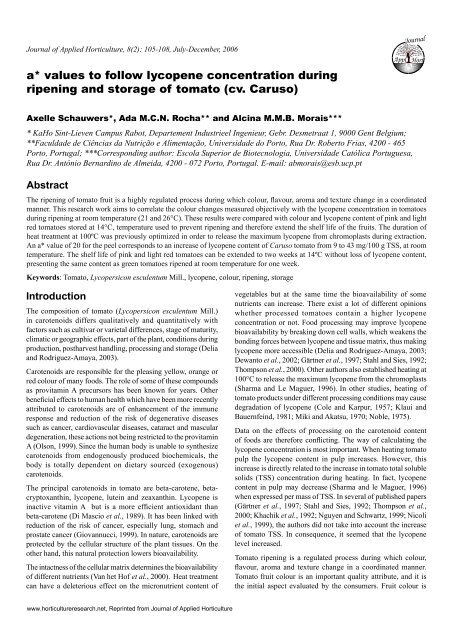Journal of Applied Horticulture, Vol 8(2)
Journal of Applied Horticulture, Vol 8(2)
Journal of Applied Horticulture, Vol 8(2)
Create successful ePaper yourself
Turn your PDF publications into a flip-book with our unique Google optimized e-Paper software.
<strong>Journal</strong> <strong>of</strong> <strong>Applied</strong> <strong>Horticulture</strong>, 8(2): 105-108, July-December, 2006a* values to follow lycopene concentration duringripening and storage <strong>of</strong> tomato (cv. Caruso)Appl<strong>Journal</strong>Axelle Schauwers*, Ada M.C.N. Rocha** and Alcina M.M.B. Morais**** KaHo Sint-Lieven Campus Rabot, Departement Industrieel Ingenieur, Gebr. Desmetraat 1, 9000 Gent Belgium;**Faculdade de Ciências da Nutrição e Alimentação, Universidade do Porto, Rua Dr. Roberto Frias, 4200 - 465Porto, Portugal; ***Corresponding author: Escola Superior de Biotecnologia, Universidade Católica Portuguesa,Rua Dr. António Bernardino de Almeida, 4200 - 072 Porto, Portugal. E-mail: abmorais@esb.ucp.ptAbstractThe ripening <strong>of</strong> tomato fruit is a highly regulated process during which colour, flavour, aroma and texture change in a coordinatedmanner. This research work aims to correlate the colour changes measured objectively with the lycopene concentration in tomatoesduring ripening at room temperature (21 and 26°C). These results were compared with colour and lycopene content <strong>of</strong> pink and lightred tomatoes stored at 14°C, temperature used to prevent ripening and therefore extend the shelf life <strong>of</strong> the fruits. The duration <strong>of</strong>heat treatment at 100ºC was previously optimized in order to release the maximum lycopene from chromoplasts during extraction.An a* value <strong>of</strong> 20 for the peel corresponds to an increase <strong>of</strong> lycopene content <strong>of</strong> Caruso tomato from 9 to 43 mg/100 g TSS, at roomtemperature. The shelf life <strong>of</strong> pink and light red tomatoes can be extended to two weeks at 14ºC without loss <strong>of</strong> lycopene content,presenting the same content as green tomatoes ripened at room temperature for one week.Keywords: Tomato, Lycopersicon esculentum Mill., lycopene, colour, ripening, storageIntroductionThe composition <strong>of</strong> tomato (Lycopersicon esculentum Mill.)in carotenoids differs qualitatively and quantitatively withfactors such as cultivar or varietal differences, stage <strong>of</strong> maturity,climatic or geographic effects, part <strong>of</strong> the plant, conditions duringproduction, postharvest handling, processing and storage (Deliaand Rodriguez-Amaya, 2003).Carotenoids are responsible for the pleasing yellow, orange orred colour <strong>of</strong> many foods. The role <strong>of</strong> some <strong>of</strong> these compoundsas provitamin A precursors has been known for years. Otherbeneficial effects to human health which have been more recentlyattributed to carotenoids are <strong>of</strong> enhancement <strong>of</strong> the immuneresponse and reduction <strong>of</strong> the risk <strong>of</strong> degenerative diseasessuch as cancer, cardiovascular diseases, cataract and masculardegeneration, these actions not being restricted to the provitaminA (Olson, 1999). Since the human body is unable to synthesizecarotenoids from endogenously produced biochemicals, thebody is totally dependent on dietary sourced (exogenous)carotenoids.The principal carotenoids in tomato are beta-carotene, betacryptoxanthin,lycopene, lutein and zeaxanthin. Lycopene isinactive vitamin A but is a more efficient antioxidant thanbeta-carotene (Di Mascio et al., 1989). It has been linked withreduction <strong>of</strong> the risk <strong>of</strong> cancer, especially lung, stomach andprostate cancer (Giovannucci, 1999). In nature, carotenoids areprotected by the cellular structure <strong>of</strong> the plant tissues. On theother hand, this natural protection lowers bioavailability.The intactness <strong>of</strong> the cellular matrix determines the bioavailability<strong>of</strong> different nutrients (Van het H<strong>of</strong> et al., 2000). Heat treatmentcan have a deleterious effect on the micronutrient content <strong>of</strong>vegetables but at the same time the bioavailability <strong>of</strong> somenutrients can increase. There exist a lot <strong>of</strong> different opinionswhether processed tomatoes contain a higher lycopeneconcentration or not. Food processing may improve lycopenebioavailability by breaking down cell walls, which weakens thebonding forces between lycopene and tissue matrix, thus makinglycopene more accessible (Delia and Rodriguez-Amaya, 2003;Dewanto et al., 2002; Gärtner et al., 1997; Stahl and Sies, 1992;Thompson et al., 2000). Other authors also established heating at100°C to release the maximum lycopene from the chromoplasts(Sharma and Le Maguer, 1996). In other studies, heating <strong>of</strong>tomato products under different processing conditions may causedegradation <strong>of</strong> lycopene (Cole and Karpur, 1957; Klaui andBauernfeind, 1981; Miki and Akatsu, 1970; Noble, 1975).Data on the effects <strong>of</strong> processing on the carotenoid content<strong>of</strong> foods are therefore conflicting. The way <strong>of</strong> calculating thelycopene concentration is most important. When heating tomatopulp the lycopene content in pulp increases. However, thisincrease is directly related to the increase in tomato total solublesolids (TSS) concentration during heating. In fact, lycopenecontent in pulp may decrease (Sharma and le Maguer, 1996)when expressed per mass <strong>of</strong> TSS. In several <strong>of</strong> published papers(Gärtner et al., 1997; Stahl and Sies, 1992; Thompson et al.,2000; Khachik et al., 1992; Nguyen and Schwartz, 1999; Nicoliet al., 1999), the authors did not take into account the increase<strong>of</strong> tomato TSS. In consequence, it seemed that the lycopenelevel increased.Tomato ripening is a regulated process during which colour,flavour, aroma and texture change in a coordinated manner.Tomato fruit colour is an important quality attribute, and it isthe initial aspect evaluated by the consumers. Fruit colour iswww.horticultureresearch.net, Reprinted from <strong>Journal</strong> <strong>of</strong> <strong>Applied</strong> <strong>Horticulture</strong>


